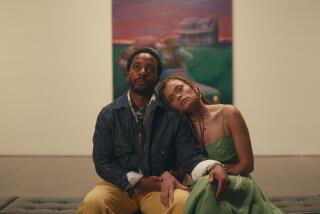Artist Paints the Story of His Painful Crash Recovery
- Share via
Jet-set artist Andre Miripolsky was sipping champagne and surveying the glittery crowd at the wedding of Los Angeles restaurateurs Wolfgang Puck and Barbara Lazaroff when a stranger approached and introduced himself.
The setting was a tiny cliffside town in the South of France; the stranger was Dr. Norman Leaf, an admirer of the Miripolsky oeuvre and a plastic surgeon who would later play an important part in the artist’s future.
Less than a week later, as Miripolsky drove home from Los Angeles International Airport, he lost control of his car and was nearly killed in the ensuing crash (jet-lagged, he said, he fell asleep at the wheel).
For the next 3 1/2 weeks, he would be in the UCLA Medical Center--legs and hips broken, his face a distorted mass, transformed into a grotesque face not unlike those populating his colorful paintings. One look in a mirror and Miripolsky knew that it was going to take a lot of work to put him back together again.
As medical personnel worked to restore him to health, Miripolsky, always the artist, recorded his impressions in a series of autobiographical illustrations.
At the urging of his father, artist Bert Miripolsky, the illustrations have been assembled into a book to be published this summer by Pasadena’s TwelveTrees Press. Called “Fear No Art: A Crash Course in Reality,” Andre Miripolsky’s book is a gritty concoction of pain, sex, humor and joy illustrating one man’s rude awakening to himself.
In a gesture of thanks to UCLA’s nonprofit Plastic Surgery Foundation, which paid for the major portion of the surgery nearly two years ago, Miripolsky said he will donate proceeds from the book back to the foundation. Though he had no insurance, the 34-year-old artist said the question of how he was going to pay for $80,000 worth of operations had been the furthest thing from his mind. Grateful to be alive, his attentions were singularly focused on regaining his health.
It was one month after his accident, back at his West Los Angeles studio, that Miripolsky had a visit from Leaf, an assistant clinical professor of surgery in UCLA’s plastic surgery division.
After determining that more reconstructive surgery was needed, Leaf cut through hospital red tape to arrange another operation the following week--surgery that saved the facial nerves from permanent paralysis and restored his features to a remarkable semblance of their former state, according to Miripolsky. Leaf was also instrumental in obtaining the Plastic Surgery Foundation funds that paid for most of Miripolsky’s surgery, the artist noted.
A Fascinating Experience
Painful as his recovery was, Miripolsky said, he “found the whole experience fascinating. It was like having my own ‘Nova’ show, only I was the center of it, watching it happen. First thing every morning, I would grab the mirror I kept by my bed, and my face would be different each time. It was like having my own garden, watching the healing process. I found the entire process invigorating.”
Right after the accident, Miripolsky resisted encouragement from doctors to draw or paint as a form of therapy. He said he found “rediscovering” himself so enjoyable, he refused to do anything else.
He said he eventually began the “Fear No Art” series out of guilt, after receiving several insightful art post cards from someone he didn’t even know. Determined to reciprocate for his correspondent’s encouragement, he grabbed the nearest material, which turned out to be cardboard, and created the first illustration, which he sent to his new pen pal. The drawings continued to flow until he had completed 50 of them.
Disorienting Life Style
Miripolsky, who bounced around the world eight times before graduating from high school in Seoul, Korea, learned to paint at an early age, using art to anchor a thoroughly disorienting life style, he said. By the age of 9, he said, he was selling his work. He has since designed a promotional package for one of Bette Midler’s albums, costumes for Elton John and many sculptural installations such as those on view at Cedars-Sinai Medical Center and Spago, the Puck-Lazaroff restaurant.
“If you listen to Andre long enough,” said Leaf, “you will believe that nothing happens by chance. The circumstances around all of this are so unusual--everything works together so beautifully, that through his contribution so many people will be helped, just as he was helped. It’s like a work of fiction but it’s real.”
More to Read
Sign up for our Book Club newsletter
Get the latest news, events and more from the Los Angeles Times Book Club, and help us get L.A. reading and talking.
You may occasionally receive promotional content from the Los Angeles Times.










